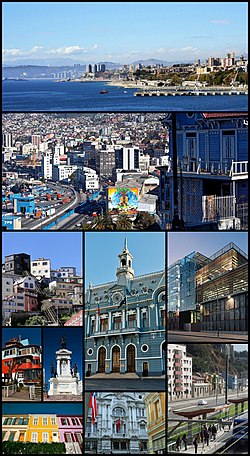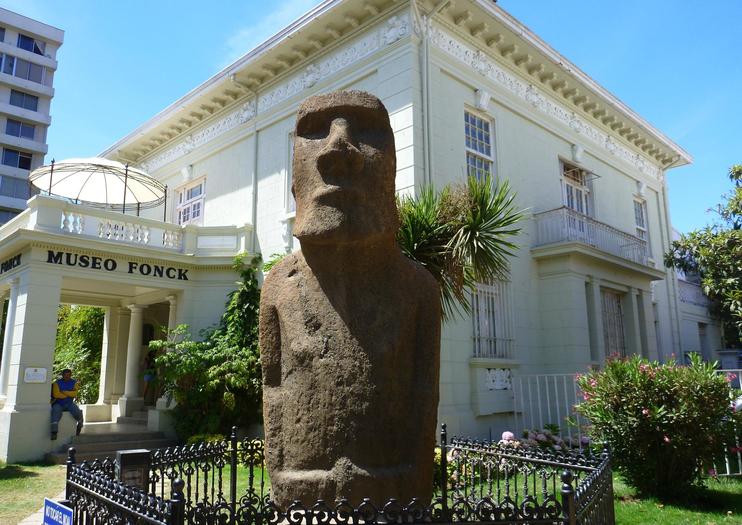Sunday, December 8, 2019, Valparaiso/Santiago, Chile
Blanketed with green parks and set at the foot of snow capped
Andean peaks, Chile’s modern capital of Santiago is one of the largest cities
in the Americas. Its impressive
neoclassical, neo-Gothic, art deco, and other architecture spans several
centuries. Santiago’s gateway,
Valparaiso, is often compared to San Francisco for its many ceros, or hills. The city prospered as a major port until the
opening of the Panama Canal rendered it unnecessary. Here, quaint Victorian era architecture
recalling its 19th century affluence and steeply sloped barrios are linked by ascensores, or funiculars, and winding
byways. Valparaiso’s more extravagant
neighbor, the resort town of Vina del Mar, was founded by well-to-do Chileans
seeking refuge from city life on long sandy shores.
Valparaíso is a major city, seaport, and educational center in the commune of Valparaíso, Chile. "Greater Valparaíso" is the third largest metropolitan area in the country. Valparaíso is located about 75 miles northwest of Santiago by road and is one of the South Pacific's most important seaports. Valparaíso is the capital of Chile's second most populated administrative region and has been the headquarters for the Chilean National Congress since 1990. Valparaíso has seven universities.
The population of Valparaiso is three-hundred thousand, Chile eighteen million, and Santiago 5.8 million. The primary exports are copper, lithium, wine, sea food, and olive and avocado oils. China is the primary recipient of these exports.

The population of Valparaiso is three-hundred thousand, Chile eighteen million, and Santiago 5.8 million. The primary exports are copper, lithium, wine, sea food, and olive and avocado oils. China is the primary recipient of these exports.
Views from our arriving cruise ship.
Very large dry dock, parked close to our ship.

Valparaíso played an important geopolitical role in the second half of the 19th century, when the city served as a major stopover for ships traveling between the Atlantic and Pacific oceans by crossing the Straits of Magellan. Valparaíso mushroomed during its golden age, as a magnet for European immigrants, when the city was known by international sailors as "Little San Francisco" and "The Jewel of the Pacific." In 2003, the historic quarter of Valparaíso was declared a United Nations Educational, Scientific, and Cultural Organization (UNESCO) World Heritage site.
Notable features include Latin America's oldest stock exchange, the continent's first volunteer fire department, Chile's first public library, and the oldest Spanish language newspaper in continuous publication in the world, El Mercurio de Valparaíso.
The second half of the twentieth century was unfavorable to Valparaíso, as many wealthy families abandoned the city. The opening of the Panama Canal and reduction in ship traffic dealt a serious blow to Valparaíso's port-based economy. Over the first 15 years of the twenty-first century the city reached a recovery, attracting artists and cultural entrepreneurs who have set up in the city's hillside historic districts. Today, many thousands of tourists visit Valparaíso from around the world to enjoy the city's labyrinth of cobbled alleys and colorful buildings. The port of Valparaíso continues to be a major distribution center for container traffic, copper, and fruit exports. Valparaíso also receives growing attention from cruise ships that visit during the South American summer. Most significantly, Valparaíso has transformed itself into a major educational center with four large traditional universities and several large vocational colleges. The city exemplifies Chilean culture, with festivals every year, and street artists and musicians.


The Plaza Sotomayor is a plaza in Valparaíso, Chile. It is named after Rafael Sotomayor. The square is lined by buildings occupying full block-fronts of the streets that flank it. The focus of the square is the monument that honors the Chilean sailors who fell during the Battle of Iquique and the Battle of Punta Gruesa. The plaza and surrounding buildings was designated a Zona Típica (historic district) on January 23, 1979.
At the northeastern side of the square are two similar towers, which create a sort of gate entrance to the port from the city. On the opposite side is the building that housed the Intendencia de Valparaíso, which currently is home to the headquarters of the Chilean Navy. The building used by the CSAV and the building that houses the National Council of Culture and the Arts also face the plaza.
Hotel Reina Victoria.
Funicular.
Flowers inside a round-a-bout.

View of Flower Clock, one of the main tourist landmarks at entrance to Vina del Mar. Viña del Mar (meaning "Vineyard of the Sea") is a city and commune on central Chile's Pacific coast. Often referred to as La Ciudad Jardín ("The Garden City"), Viña del Mar is located within the Valparaíso Region, and it is Chile's fourth largest city with a population of 324,836 (according to the 2012 census). Viña del Mar is also part of the Greater Valparaíso area, the country's third largest metropolitan area (pop. 803,683, 2002 census), after the Metropolitan areas of Santiago and Concepción. The Greater Valparaíso Area is home to five municipalities: Valparaíso, Viña del Mar, Concon, Quilpue and Villa Alemana.
On our way into Vina del Mar, a very upscale neighborhood. Valparaiso's more extravagant neighbor, the resort town of Vina del Mar, was founded by well-to-do Chileans seeking refuge from city life on long sandy shores.
Casino.
Chile's presidential summer home.
Our cruise ship from miles away via telephoto lens.
Casino hotel on Ocean side.
Casino park.
Kids playground.
Another view of president's summer home.
More views of casino.
Sheraton hotel.
We made a stop at a museum to see artifacts from Easter Island.

Visitors to the Corporate Museum of Archaeology and History Francisco Fonck, or the Fonck Museum for short, are greeted by two original moai from Easter Island. The museum was founded in 1937 and named after German physician and archeologist Dr. Francisco Fonck Foveaux, who was based in Chile.
Looks Hawaiian to Larry.
Santiago, also known as Santiago de Chile, is the capital and largest city of Chile as well as one of the largest cities in the Americas. It is the center of Chile's largest and most densely populated conurbation, the Santiago Metropolitan Region, whose total population is 7 million of Chile's 18 million. The city is entirely located in the country's central valley. Most of the city lies between 1,640 feet and 2,133 feet above mean sea level.
Founded in 1541 by the Spanish conqueror Pedro de Valdivia, Santiago has been the capital city of Chile since colonial times. The city has a downtown core of 19th-century neoclassical architecture and winding side-streets, dotted by art deco, neo-gothic, and other styles. Santiago's cityscape is shaped by several stand-alone hills and the fast-flowing Mapocho River, lined by parks such as Parque Forestal. The Andes Mountains can be seen from most points in the city. These mountains contribute to a considerable smog problem, particularly during winter. The city outskirts are surrounded by vineyards and Santiago is within an hour of both the mountains and the Pacific Ocean.
Santiago is the cultural, political, and financial center of Chile and is home to the regional headquarters of many multinational corporations. The Chilean executive and judiciary are located in Santiago, but Congress meets mostly in nearby Valparaíso. Santiago is named after the biblical figure St. James. Santiago will host the 2023 Pan American Games.
We will be in Valparaiso three days and two nights. Tuesday our excursion will be to a winery (with samples!) and another visit to sights in Valparaiso.













































































Comments
Post a Comment